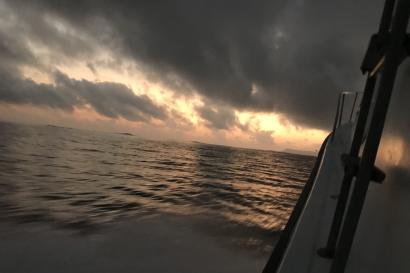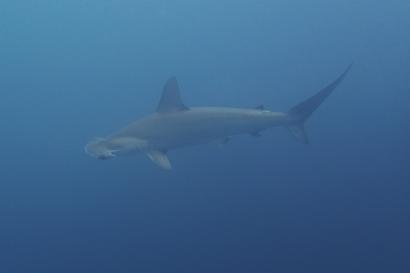
Note: This is a follow up to my last post, How It All Went Wrong, Part 1. For context, you should read it before you read this.
Drifting in and out of consciousness, the accumulation of several sleepless nights, the gray haze of predawn on the Pacific settles into the far corners of the mind. As we tore away from Isabela, east towards a gathering glow, the absurdity of the situation felt just as hazy: a beginning, an end, an evacuation and a new journey. Each time I jolted my lolling head awake the sky was lighter, a different jagged rock splitting the horizon. Where was the continuity? How much ground have we covered? The soft glow of early morning made the Shearwaters pop out against the water, their low glides mirrored in the slightest smudge of glossy reflection.
I’m not going to recount the details of the days that followed. The long periods of uncertainty and nail-biting unease that defined our rushed return to the mainland and subsequent encampment in an airport hotel are hard to capture in a narrative; it almost feels they’d be best represented by long blank patches on the page. What was there to feel? The relief of finally securing a flight home felt palpably absurd in the face of rushed goodbyes; situations changed rapidly and, one by one, friends disappeared through the revolving doors of the hotel lobby into the chaos beyond. As it became clear not everyone would make it out before the travel ban went into place, solidarity was challenged: who could leave and who would be left behind started to feel arbitrary. Flights were canceled, last-minute deals were pulled off over the phone, and nothing felt guaranteed anymore. Still, we held each other close in cramped hotel rooms, laughed in the face of crisis, and when each last-minute departure came sweeping through the conversation like a typhoon we all made our way downstairs together and hugged farewell in sweatpants and flip-flops.
Quito was gray. Flat bottomed clouds the color of woodsmoke ran perpendicular to the distant slope; a misty rain darkened the asphalt and dripped from the deep green of ornamental plantings. The Galapagos had never felt further away.
We all made it out, eventually. IES Abroad and the GAIAS team worked tirelessly, miraculously, and the small group of students I ended up leaving behind (I was one of the last to go, on the final commercial flight) ended up seeing one more bit of Ecuador as they made a mad dash for Guayaquil and a chartered plane that could get them home safe.
To Miami then, with a small group of stalwart companions (these bonds resist severance with gusto) and then to New York, alone. Here’s what I wrote immediately after touching down.
“It’s March, and the colors of New York are drained and muted. Mold green, chipped rust and cement divert snowmelt, collecting dirty puddles that trickle towards the marsh. From overhead the boxy houses sprawl out in all directions, cookie-cutter trinkets on damp lawns, and as we pass over empty parks and clogged tidal creeks I shuffle endlessly through the music on my phone, listless and longing for relief. I hang on to each song for a moment, listening, looking for something – some indication that this emptiness has precedent, evidence of its transformative power – and I find nothing. My head droops against the window’s edge, the wall of the plane cold and lifeless. The coffee shops below are shuttered, the roads empty, no children in the grass: only sickly silence and that desperate hope for spring. This is evident from a hundred feet above. Fifty. Ten. We touch to the tarmac with an apathetic lurch.
Home. No one looks up from their laps.”
Yeah, yeah. Real sad boy hours, I know – permit me a day or two of angst. The situation was far from ideal, for more reasons than I’d care to discuss.
But here I am, safe with my family for whom I’ve never felt more grateful. And I’m home for spring – a time of year that, here in New England, gives me unending prompts for joy. Each time I venture outside my door, seeking out the quietest pockets of open space still available for solo (and socially distant) exploration, I find a piece of silver lining. Wildflowers begin to poke up through mosaic leaf litters, violet periwinkles and creamy snowdrops, and with each passing day familiar birds arrive home: Eastern Phoebes pumping their tails in sunlit clearings, emerald Tree Swallows chattering cheerfully over the water of woodland pools. Spring Peepers cry out from the swamp, Mourning Cloak butterflies cast dancing shadows on the stirring forest floor – there is no time to lose. I know that, for many of the incredible people I was privileged enough to share my abroad experience with, hope has been found in similar small moments, and it only blossoms through our continuing ability to share such moments with each other. Frequent video chats give us little windows into each other's lives; we can see and hear spring making its way across the latitudes in the flowering of backyard trees and the fluting of birdsong over Zoom microphones. We discuss what it feels like to be home, revel in vibrant memory, even swap our own bits of written reflection. And class continues, reminding us that our time on the Galapagos was not some fantastical dream – we actually saw some of the plants, explored some of these incredible places. As they say, we did that.
And I wonder where some of the birds that were wintering on the Galapagos are now. The Wandering Tattlers that hopped between foam-spray at water’s toothed edge – are they on their way back to the icy grips of Alaska by now? Are the Franklin’s Gulls already resting on some Central American beach, catching their breath before continuing to Texas? What if a storm blows in, the howling winds of chaos, and throws them off track? Where might they end up, and will they recover? The residual gale of a ferocious nor’easter bends the budding branches outside my window as I type. We are all susceptible to such forces. In the events of one freak storm, home and the Galapagos were pushed in closer proximity than I’d ever expected them to be – meeting at the ragged edge like surf on the lava rock, fostering communities and experiences that could exist nowhere else – born from the tumult, surviving in the ebb and flow.
We are making do. Taking it all in stride. Sure, it all went wrong. But just ask the archipelago – fire and fury, once cooled, can turn to Eden in the blink of an eye. And now, as the intimate and unavoidable ties of community are laid bare as never before, we look forward – to hope, to solidarity, to questioning and re-evaluation. The adventure continues.
I hope everyone is feeling safe, healthy, and secure, and I hope you all remain that way as this crisis plays out. Much love to you all.
Cheers, comrades.
Brendan

Brendan Murtha
<p>Hi everyone! My name is Brendan, and I'm a junior at Bowdoin College (Brunswick, ME) studying Ecology, Evolution, and Marine Biology. I'm passionate and curious about all things natural history related, and although my main focus has always been birds, I am just as likely to be found photographing dragonflies or catching snakes as I am craning my neck to look at the skies. These interests have also led me down paths of human ecology, conservation, and all things political, and I enjoy exploring such topics in my writing, photography, and music. I'm super excited to be part of the GAIAS program this semester, and hope to capture some of the magic through my posts.</p>





